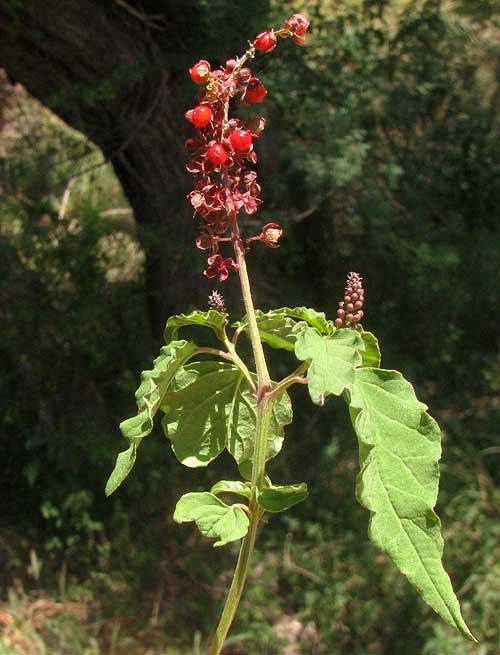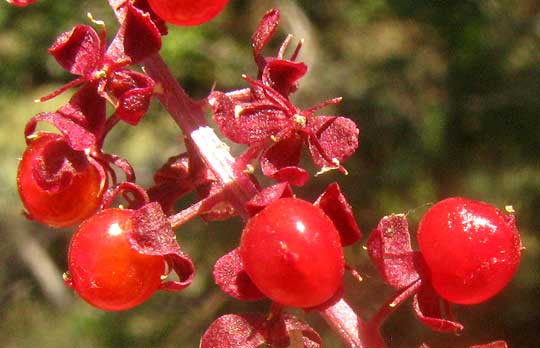Excerpts from Jim Conrad's
Naturalist Newsletter
from the July 20, 2014 Newsletter issued from the Frio Canyon Nature Education Center in the valley of the Dry Frio River in northern Uvalde County, southwestern Texas, on the southern border of the Edwards Plateau; elevation ~1750m (~5750 ft); N29.62°, W99.86°; USA
PIGEONBERRY
In blinding, mid-day light with the temperature nudging a hundred, my eye still caught a tiny flash of bright red about a foot off the ground, deep inside a dense hedgerow at the edge of Cooks Slough Nature Park on Uvalde's south side. On hands and knees I crawled into the tangle and was surprised by whom I found there. Below, you can see the pretty little plant with its 1/8th-inch-broad (3mm), red berries:

A close-up of some berries along with several old calyxes and stamen filaments where the juicy fruits have been critter-snatched, appears below:

This is an old friend from the Yucatan, a pretty species turning up again and again along trails through the shadowy, scrubby woods around Chichén Itzá and around my old hut. II had no idea it occurred this far north. In English it's called Pigeonberry, Rouge Plant, Baby Peppers and other names. It's RIVINA HUMILIS, and if you pay attention to the fruiting head's general appearance and the succulent berries you'll have no trouble believing that Pigeonberry is a member of the Pokeweed Family, the Phytolaccaceae. Doesn't its slender raceme of fruits remind you of a Pokeweed's narrow, curving fruiting heads, each little berry on its own short stem, or pedicel?
Our Pigeonberry wasn't flowering, but you can see flowers on a plant near my hut back in the Yucatan at http://www.backyardnature.net/yucatan/pigeonby.htm.
Our hedgerow Pigeonberry struck me as an herb not over knee high, but I know from the Yucatan that it can grow head-high, and its stems arise from perennial, woody bases. It loves shade modestly dappled with flecks of sunlight, both up here and in the Yucatan.
The plant looks delicate, and that day in the heavy heat its leaves crinkled and wilted in the dry air, but this is a tough species, as can be believed from its extensive distribution area stretching from Argentina in South America through all of tropical America into the US from Arizona to Florida as far north as Oklahoma. It's also become invasive in the Old World, where it's often been introduced into gardens because of its prettiness, its medicinal uses, and, especially, the use of juice from its red fruits to redden lips, cheeks or whatever part of the body needing reddening -- thus the other common name "Rouge Plant."
Delena Tull in her 1999 book Edible and Useful Plants of Texas and the Southwest: A Practical Guide says that all parts of the plant are considered toxic, "with toxicity similar to that of its larger relative poke." I've nibbled on ripe fruits of both Pigeonberry and Poke, found them similarly as bitter as they are tasty, and never have suffered any ill effects. I never eat many, though.